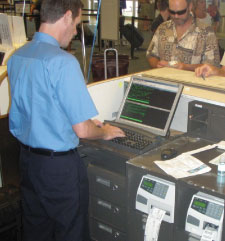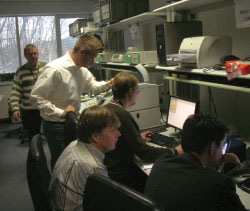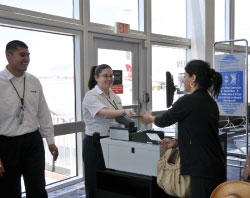
The CUPPS technology is expected to provide significant savings to airports and airlines by introducing a uniform electronic interface for passenger applications.
It is expected that the CUPPS technology will provide significant savings to airports and airlines by introducing a uniform electronic interface for passenger applications. Developed by the aviation industry, in coordination with IATA, ACI and the Air Transport Association, CUPPS will give software developers at all airlines a common set of specifications, eliminating costly custom engineering and making passenger applications fully portable between airports.
The CUPPS trial phase has involved five Pilots: Las Vegas McCarran with ARINC the vendor partner, Orlando (SITA), Sacramento (AirIT), Brussels (RESA) and Dublin (Ultra Electronics). “All of the pilot trials have gone very well. The platform vendors, air carriers and airports are very pleased with the results. Most importantly, the applications have proven to be portable among the vendors, which is chief as a value proposition for CUPPS,” said Samuel Ingalls, Assistant Director of Aviation, Information Systems, Las Vegas McCarran International Airport and Chair of the CUPPS Leadership Team. “While the period of the pilots has reached an end date, in terms of updates to the Technical Specification, other air carriers will continue forward with the intent to launch their applications on a trial basis. For example, American Airlines will launch at Orlando International Airport, Las Vegas McCarran and tentatively at Sacramento International Airport.”

In September, Lufthansa became the first airline to achieve CUPPS compliance following Pilot testing at Orlando International Airport with SITA.
SITA was the first platform provider to complete its Pilot programme in August, and in September Lufthansa became the first airline to achieve CUPPS compliance following Pilot testing at Orlando International Airport with SITA.
“The key lesson learned from the Pilot was that although CUPPS is very complicated, by coming together as one community and sharing ideas, we were able to develop a new Recommended Practice (RP),” said Catherine Mayer, Vice President, Airport Services for SITA. “Even with the detailed Technical Specification there were still different interpretations of the RP by different companies and developers. The Pilot brought those different understandings to the surface and allowed the CUPPS team to enhance the Technical Standard with those lessons learned.”
Throughout the Pilot phase, if an issue was found, the participants addressed the issue and confirmed the results before continuing. The process has been completely transparent, open for input and review by all CUPPS participants, whether they were directly coding in the pilot or not.
Lufthansa used CUPPS to handle a transatlantic flight for the first time on 2 September. “The Lufthansa CUPPS Integration Platform (LH CIP) developed by Lufthansa Systems enables its full suite of passenger processing applications including check-in, boarding, weight and balance and other applications for operations and flight preparation to run successfully on the SITA CUPPS platform in Orlando,” said Kaspar Pfeifer, Vice President Production Processes, Lufthansa Information Management. “We are ready now to introduce CUPPS at any airport once IATA officially releases the CUPPS technical specification.”
Thomas Jeske, responsible project manager in Lufthansa Information Management, added: “The pilot tests with SITA and Orlando International Airport helped to prove the concept, achieving interoperability and compatibility between the SITA CUPPS platform and Lufthansa’s CUPPS applications. This is a very significant development for common-use systems throughout the air transport industry.”
Improved functionality, reduced costs

It is believed that CUPPS will be a significant improvement on the current, multiple CUTE environments that exist today. Carriers are expected to realise both cost and time savings due to the standardisation of the platforms and the streamlined certification and deployment processes.
Continental Airlines has implemented ARINC’s CUPPS passenger platform for its check-in process at Las Vegas McCarran. The platform includes full support for McCarran’s RFID baggage tag programme. “CUPPS should reduce the cost and time required to implement and deploy software changes and new applications to common use environments,” said Amy Foltz, manager technology, Continental Airlines. “Carriers will be able to create a single application that can be deployed to any CUPPS platform, regardless of supplier; therefore, it will be more cost-effective to develop, test, and deploy our applications. Airports will be able to transition to – or between – CUPPS platforms with less impact to their carriers. The standardisation of the platform should make troubleshooting issues that arise in production easier on everybody.”
ARINC fast-tracked the deployment of its CUPPS platform at Las Vegas McCarran to support the world’s first live test of CUPPS by an airline on 15 January 2009. The application has been running error-free since then and has been expanded to include gate operations for passenger boarding. “This successful launch by Continental underscores the huge potential of CUPPS to benefit the industry at large,” said Mike Picco, ARINC Vice President, Airport Systems. “CUPPS will greatly reduce the costs and lead times involved in migrating to efficient common-use operation. This changes everything.”
Ingalls said: “The pilot in Las Vegas has gone very well. We have checked in and/or boarded more than 80,000 folks throughout the course of the pilot with the Continental Airlines and WestJet CUPPS applications on the CUPPS platform. We are looking forward to hosting the American Airlines CUPPS application on the CUPPS platform in Las Vegas shortly.”
Standardisation of platforms

Airlines from all over the world have been active participants in the development of the CUPPS standard to ensure that it responds to their needs. Now that the solution has been proven to be a reality, airlines will work on migration plans for their applications.
Airlines from all over the world have been active participants in the development of the CUPPS standard to ensure that it responds to their needs. Now that the solution has been proven to be a reality, airlines will work on migration plans for their applications. “I would expect airlines to transition to CUPPS over the next two to five years, which is fine since our AirportConnect solution accommodates traditional CUTE, new CUPPS, CUSS and browser-based applications – all on the same platform. We will continue to work with the airlines on a successful migration to CUPPS at the time of their choosing,” said Mayer.
It is believed that CUPPS will be a significant improvement on the current, multiple CUTE environments that exist today. Carriers are expected to realise both cost and time savings due to the standardisation of the platforms and the streamlined certification and deployment processes. It is also forecast to improve the ability of airports to attract new airlines, as well as move or change an airline’s facility requirements based on market conditions and/or alliance demands. “I believe that the leadership team on the CUPPS project is very pleased with the progress that CUPPS has made and the industry benefits that will be realised into the distant future,” said Ingalls.







